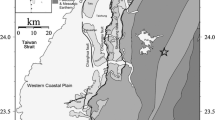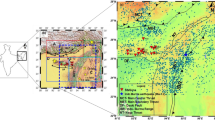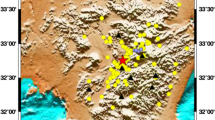Abstract
A devastating earthquake (Mw 7.4) struck near Izmit city, northwestern Turkey, on 17 August 1999. The relatively large size of this earthquake and site amplification conditions caused severe damage in the Marmara region as well as the city of Istanbul. The disastrous outcome of this large earthquake requires careful analysis of the seismic hazard including local site effects in this region. Therefore, the present work addresses the issue of local site effects and modelling of strong ground motion for this earthquake. We have estimated the soil effects using the horizontal-to-vertical (H/V) ratio. Furthermore, high-frequency records are simulated using a modified semi-empirical technique (MSET) by including estimated site effects. This modification will provide more reliable and precise simulated strong motion records. In the present study, strong ground motions are simulated at nine seismic stations in the epicentral range of 40–99 km. These stations were selected based on their recorded data quality. To validate the technique, we have compared the synthetic records with the observed records in terms of root mean square error (RMSE). This comparison includes time records, pseudo-acceleration spectra, mean period and predominant period. This comparison shows MSET has successfully simulated the 1999 Izmit earthquake.
Similar content being viewed by others
Data availability
Engineering strong motion database of ORFEUS.
Code availability
NA.
References
Aki, K. (1988). Local site effect on ground motion. Proceedings of Earthquake Engineering and Soil Dynamics, II, 103–155.
Apostolidis, P. I., Raptakis, D. G., Pandi, K. K., Manakou, M. V., & Pitilakis, K. D. (2006). Definition of subsoil structure and preliminary ground response in Aigion city (Greece) using microtremor and earthquakes. Soil Dynamics and Earthquake Engineering, 26(10), 922–940.
Bonilla, L. F., Steidl, J. H., Lindley, G. T., Tumarkin, A. G., & Archuleta, R. J. (1997). Site amplification in the San Fernando Valley, California: Variability of site-effect estimation using the S-wave, coda, and H/V methods. Bulletin of the Seismological Society of America, 87(3), 710.
Boore, D. M. (1983). stochastic simulation of high frequency ground motion based on seismological models of radiated Spectra. Bulletin of the Seismological Society of America, 73, 1865–1894.
Boore, D. M., & Atkinson, C. M. (1987). Stochastic prediction of ground motion and spectral response parameters at hard rock sites in eastern North America. Bulletin of the Seismological Society of America, 77, 440–467.
Borcherdt, R. D. (1970). Effects of local geology on ground motion near San Francisco Bay. Bulletin of the Seismological Society of America, 60, 29–61.
Brune, J. N. (1970). Tectonic stress and spectra of seismic shear waves from earthquakes. Journal of Geophysical Research, 75, 4997–5009.
Bulut, F., Bohnhoff, M., Aktar, M., & Dresen, G. (2007). characterization of aftershock-fault plane orientations of the 1999 Izmit (Turkey) earthquake using high-resolution aftershock locations. Geophysical Research Letters, 34, L20306. https://doi.org/10.1029/2007GL031154
Castro, R. R., Mucciarelli, M., Pacor, F., & Petrungaro, C. (1997). S-wave site response using horizontal to vertical spectral ratios. Bulletin of the Seismological Society of America, 87, 256–260.
Chia, K., & Lau, T. L. (2017). Relationship between soft stratum thickness and predominant frequency of ground based on microtremor observation data. In Proceeding of the 3rd International Conference of Global Network for Innovative Technology 2016 (3rd IGNITE-2016), AIP Conf. Proc., Vol. 1865, pp. 090003-1–090003-6. https://doi.org/10.1063/1.4993404
Cranswick, E., Ozel, O., Meremonte, M., Erdik, M., Safak, E., Mueller, C., Overturf, D., & Frankel, A. (2000). Earthquake damage, site response, and building response in Avcilar, West of Istanbul, Turkey. International Journal for Housing Science and Its Applications, 24(1), 85–96.
Devi, S., Sandeep, Kumar, P., & Monika. (2021). Strong-motion simulation of the 1988 Indo-Burma and scenario earthquakes in NE India by integrating site effects in a semi-empirical technique. Pure and Applied Geophysics. https://doi.org/10.1007/s00024-021-02791-2
Ergin, M., Aktar, M., Biҫmen, F., Yörük, A., Yalҫun. N., & Kuleli, S. (1998). Izmit Körfezimikrodepremҫalışması, ATAG-1, ITU.
Ergintav, S., Reilinger, R. E., Çakmak, R., Floyd, M., Çakır, Z., Doğan, U., King, R. W., McClusky, S., & Özener, H. (2014). Istanbul’s earthquake hot spots: Geodetic constraints on strain accumulation along faults in the Marmara seismic gap. Geophysical Research Letters. https://doi.org/10.1002/2014GL060985
Field, E. H., & Jacob, K. H. (1995). A comparison and test of various site-response estimation techniques, including three that are not reference-site dependent. Bulletin of the Seismological Society of America, 85, 1127–1143.
Field, E. H., Jacob, K. H., & Hough, S. H. (1992). Earthquake site response estimation: A weak-motion case study. Bulletin of the Seismological Society of America, 82, 2283–2307.
Firat, S., Isik, N. S., Arman, H., Demir, M., & Vural, I. (2016). Investigation of the soil amplification factor in the Adapazari region. Bulletin of Engineering Geology and the Environment, 75, 141–152. https://doi.org/10.1007/s10064-015-0731-z
Gülen, L., Pınar, A., Kalafat, D., Ozel, N., Horasan, G., Yılmazer, M., & Isikara, A. M. (2002). Surface fault breaks, aftershock distribution, and rupture process of the 17 August 1999, Izmit, Turkey, earthquake. Bulletin of the Seismological Society of America, 92(1), 230–244.
Hanks, T. C., & McGuire, R. K. (1981). The character of high frequency ground motion. Bulletin of the Seismological Society of America, 71, 2071–2095.
Irikura, K. (1986). Prediction of strong acceleration motion using empirical Green’s function. Proceedings of the 7th Japan Earthquake Engineering Symposium, pp. 151–156.
Irikura, K., & Kamae, K. (1994). Estimation of strong ground motion in broad-frequency band based on a seismic source scaling model and an Empirical Green’s function technique. Annals of Geofis XXXVII, 6, 1721–1743.
Joshi, A. (2001). Strong motion modelling of the source of the Chamoli earthquake of March 29, 1999 in the Garhwal Himalaya, India. Journal of Seismology, 5, 499–518.
Joshi, A. (2004). A simplified technique for simulating wide band strong ground motion for two recent Himalaya earthquakes. Pure and Applied Geophysics, 161, 1777–1805.
Joshi, A., & Midorikawa, S. (2004). A simplified method for simulation of strong ground motion using rupture model of the earthquake source. Journal of Seismology, 8, 467–484.
Kameda, H., & Sugito, M. (1978). Prediction of strong earthquake motions by evolutionary process model. In Proceedings of the Sixth Japan Earthquake Engineering Symposium, 41–48.
Kanamori, H. (1979). A semi empirical approach to prediction of long period ground motions from great earthquakes. Bulletin of the Seismological Society of America, 69, 1645–1670.
Kanamori, H., & Anderson, D. L. (1975). Theoretical basis of some empirical relations in seismology. Bulletin of the Seismological Society of America, 65, 1073–1095.
Karabulut, H., Bouin, M., Bouchon, M., Dietrich, M., Cornou, C., & Aktar, M. (2002). The seismicity in the eastern Marmara Sea after the 17 August 1999 Izmit earthquake. Bulletin of the Seismological Society of America, 92, 387–393.
Kramer, S. L. (1996). Geotechnical earthquake engineering. Engineering, 6, 653.
Kudo, K., Kanno, T., Okada, H., Özel, O., Erdik, M., Sasatani, T., Higashi, S., Takahashi, M., & Yoshida, K. (2002). Site-specific issues for strong ground motions during the Kocaeli, Turkey, Earthquake of 17 August 1999, as inferred from array observations of microtremors and aftershocks. Bulletin of the Seismological Society of America, 92(1), 448–465.
Kumar, A., Harinarayan, N. H., & Baro, O. (2015). High amplification factor for low amplitude ground motions: Assessment for Delhi. Disaster Advances, 8(12), 1–15.
Kumar, D., Teotia, S. S., & Khattari, K. N. (1997). The representation of attenuation characterstics of strong ground motion observed in the 1996 Dharamshala and 1991 Uttarkasshi earthquakes by available Empirical relations. Current Science, 73, 543–548.
Lay, T., & Wallace, T. C. (1995). Modern global seismology. Academic Press.
Lermo, J., & Chavez-Garcia, F. J. (1993). Site effect evaluation using spectral ratios with only one station. Bulletin of the Seismological Society of America, 83, 1574–1594.
Midorikawa, S. (1993). Semi empirical estimation of peak ground acceleration from large earthquakes. Tectonophysics, 218, 287–295.
Mittal, H., & Kumar, A. (2015). Stochastic finite-fault modeling of Mw 5.4 earthquake along Uttarakhand-Nepal border. Natural Hazards, 75(2), 1145–1166.
Mittal, H., Kumar, A., & Kamal. (2012a). Ground motion estimation in Delhi from postulated regional and local earthquakes. Journal of Seismology. https://doi.org/10.1007/s10950-012-9340-5
Mittal, H., Kumar, A., & Kumar, A. (2013). Site effects estimation in Delhi from the Indian strong motion instrumentation network. Seismological Research Letters, 84(1), 33–41.
Mittal, H., Kumar, A., Kumar, A., & Kamal. (2012b). Estimation of ground motion in Delhi using 7th September 2011 Earthquake. Paper ID 0283, 15WCEE, Lisbon.
Mittal, H., Wu, Y. M., Kumar, A., Kumar, A., & Sharma, B. (2016). Evaluating the effects of ground motion parameters on response spectra in Uttarakhand Himalayas, India. Arabian Journal of Geosciences, 9, 712. https://doi.org/10.1007/s12517-016-2747-5
Mohamed, A. M. E., Hafiez, H. E. A., & Taha, M. A. (2013). Estimating the near-surface site response to mitigate earthquake disasters at the October 6th city, Egypt, using HVSR and seismic techniques. NRIAG Journal of Astronomy and Geophysics, 2, 146–165.
Mondal, J. K., & Kumar, A. (2016). Impact of higher frequency content of input motion upon equivalent linear site response analysis for the study area of Delhi. Geotechnical and Geological Engineering, 35(3), 959–981.
Monika, Kumar, P., Sandeep, Kumar, S., Joshi, A., & Devi, S. (2020). Spatial variability studies of attenuation characteristics of Qα and Qβ in Kumaon and Garhwal region of NW Himalaya. Natural Hazards. https://doi.org/10.1007/s11069-020-04031-7
Nakamura, Y. (1989). A method for dynamic characteristics of estimation of subsurface using microtremor on the ground. Q. Rep. RTRI 30, 1.
Nath, S. K., Sengupta, P., & Kayal, J. R. (2002). Determination of site response at Garhwal Himalayas from the aftershock sequence of 1999 Chamoli earthquake. Bulletin of the Seismological Society of America, 92, 1071–1081.
Oglesby, D. D., Mai, P. M., Atakan, K., & Pucci, S. (2008). Dynamic models of earthquakes on the North Anatolian fault zone under the Sea of Marmara: Effect of hypocenter location. Geophysical Research Letters. https://doi.org/10.1029/2008GL035037.
Okay, A. I., Özcan, A. K., Imren, C., Güney, A. B., Demirbağ, E., & Kuşҫu, I. (2000). Active faults and evolving strike-slip basins in the Marmara Sea, northwest Turkey: A multichannel seismic reflection study. Tectonophysics, 321, 189–218.
Onishi, Y., Horike, M., & Kawamoto, Y. (2004). A method for simulating three-component, near-fault, strong ground motions using stochastic Green's function.
Örgülü, G., & Aktar, M. (2001). Regional moment tensor inversion for strong aftershocks of the August 17, 1999 Izmit earthquake (Mw = 7.4). Geophysical Research Letters, 28, 371–374.
Özalaybey, S., Ergin, M., Aktar, M., Tapırdamaz, C., Biҫmen, F., & Yörük, A. (2002). The 1999 Izmit earthquake sequence in Turkey: Seismological and tectonic aspects. Bulletin of the Seismological Society of America, 92, 376–386.
Ozcep, F., Karabulut, S., Özel, O., Ozcep, T., Imre, N., & Zarif, H. (2014). Liquefaction-induced settlement, site effects and damage in the vicinity of Yalova City during the 1999 Izmit earthquake, Turkey. Journal of Earth System Science, 123(1), 73–89.
Parsons, T., Toda, S., Stein, R. S., Barka, A., & Dieterich, J. H. (2000). Heightened odds of large earthquakes near Istanbul: An interaction based probability calculation. Science, 288, 661–665.
Rathje, E. M., Abrahamson, N., & Bray, J. D. (1998). Simplified frequency content estimates of earthquake ground motions. Journal of Geotechnical Engineering, 124, 150–159.
Reilinger, R., Toksoz, N., & McClusky, S. (2001). 1999 Izmit, Turkey earthquake was no surprise. GSA Today, 10(1), 1–6.
Sandeep, Joshi, A., Devi, S., Kumar, P., Sah, S. K., Lal, S., & Kamal. (2019a). Strong motion generation area modelling of the 2008 Iwate earthquake, Japan using modified semi-empirical technique. Journal of Earth and System Science, 128, 202. https://doi.org/10.1007/s12040-019-1221-7
Sandeep, Joshi, A., Kamal, Kumar, P., & Kumar, A. (2014a). Effect of frequency dependent radiation pattern in simulation of high frequency ground motion of Tohoku earthquake using modified semi empirical method. Natural Hazards, 73, 1499–1521.
Sandeep, Joshi, A., Kamal, Kumar, P., Kumar, A. & Dhibar, P. (2015). Modelling of strong motion generation areas of the Niigata, Japan, earthquake of 2007 using modified semi empirical technique. Natural Hazards 77, 933–957.
Sandeep, Joshi, A., Kamal, Kumar, P., & Kumari, P. (2014b). Modelling of strong motion generation area of the Uttarkashi earthquake using modified semi-empirical approach. Natural Hazards, 73, 2041–2066.
Sandeep, Joshi, A., Kumari, P., Kumar, P., Sah, S. K., Lal, S., & Singh, N. P. (2020). Strong ground motion simulation techniques—A review in world context. Arabian Journal of Geosciences. https://doi.org/10.1007/s12517-020-05583-5
Sandeep, Joshi, A., Kumari, P., Lal, S., Vandana, Kumar, P., & Kamal. (2017a). Emergence of the semi-empirical technique of strong ground motion simulation: A review. Journal of Geological Society of India 89, 719–722.
Sandeep, Joshi, A., Lal, S., Kumar, P., Vandana, Sah, S. K., & Kamal. (2017c). Simulation of strong ground motion of the 2009 bhutan earthquake using modified semi empirical technique. Pure and Applied Geophysics. https://doi.org/10.1007/s00024-017-1663-2
Sandeep, Joshi, A., Sah, S. K., Kumar, P., Lal, S., Devi, S., & Monika. (2019b). Modelling of 2011 IndoNepal Earthquake and Scenario Earthquakes in the Kumaon Region and Comparative Attenuation Study Using PGA Distribution with the Garhwal Region. Pure and Applied Geophysics. https://doi.org/10.1007/s00024-019-02232-1
Sandeep, Joshi, A., Sah, S. K., Kumar, P., Lal, S., & Kamal. (2019c). Modelling of strong motion generation areas for a great earthquake in central seismic gap region of Himalayas using the modified semi-empirical approach. Journal of Earth and System Science. https://doi.org/10.1007/s12040-019-1126-5
Sandeep, Joshi, A., Sah, S. K., Kumar, P., Lal, S., Vandana, K., & Singh, R. S. (2017b). Source model estimation of the 2005 Kyushu Earthquake, Japan using Modified Semi Empirical Technique. Journal of Asian Earth Sciences, 147, 240–253.
Sandhu, M., Sharma, B., Mittal, H., & Chingtham, P. (2020a). Analysis of the site effects in the north east region of India using the recorded strong ground motions from moderate earthquakes. Journal of Earthquake Engineering. https://doi.org/10.1080/13632469.2020.1724214
Sandhu, M., Sharma, B., Mittal, H., Yadav, R. B. S., Kumar, D., & Teotia, S. S. (2020b). Simulation of strong ground motion due to active Sohna fault in Delhi, National Capital Region (NCR) of India: An implication for imminent plausible seismic hazard. Natural Hazards, 104, 2389–2408. https://doi.org/10.1007/s11069-020-04277-1
Seht, I.-V., & Wohlenberg, J. (1999). Microtremor measurements used to map thickness of soft sediments. Bulletin of the Seismological Society of America, 89, 250–259.
Şengör, A. M. C., Tüysüz, O., İmren, C., Sakınç, M., Eyidoğan, H., Görür, N., Pichon, X. L., & Rangin, C. (2005). The North Anatolian Fault: A new look. Annual Review of Earth and Planetary Sciences, 33, 37–112. https://doi.org/10.1146/annurev.earth.32.101802.120415
Tibi, R., Bock, G., Xia, Y., Baumbach, M., Grosser, H., Milkereit, Karaksa, C., Zünbül, S., Kind, R., & Zschau, J. (2001) Rupture processes of the 1999 August 17 Izmit and November 12 Duzce (Turkey) earthquakes. Geophysics Journal International 144, F1–F7.
Toksoz, M. N., Shakal, A. F., & Michael, A. J. (1979). Space-time migration of earthquakes along the North Anatolian fault zone and seismic gaps. Pure and Applied Geophysics, 117, 1258–1270.
USGS (1999). Implications for Earthquake Risk Reduction in the United States from the Kocaeli, Turkey, Earthquake of August 17, 1999, U.S. Geological Survey Circular 1193.
Wells, L. D., & Coppersmith, K. J. (1994). New empirical relationships among magnitude, rupture length, rupture width, rupture area and surface displacement. Bulletin of the Seismological Society of America, 84, 974–1002.
Yamamoto, Y., Takahashi, N., Pinar, A., Kalafat, D., Citak, S., Comoglu, M., Polat, R., & Kaneda, Y. (2017). Geometry and segmentation of the North Anatolian Fault beneath the Marmara Sea Turkey, deduced from long-term ocean bottom seismographic observations. JGR Solid Earth. https://doi.org/10.1002/2016JB013608
Yu, G., Khattri, K. N., Anderson, J. G., Brune, J. N., & Zeng, Y. (1995). Strong ground motion from the Uttarkashi, Himalaya, India, earthquake: Comparison of observations with synthetics using the composite source model. Bulletin of the Seismological Society of America, 85, 31–50.
Zeng, Y., Anderson, J. G., & Su, F. (1994). A composite source model for computing realistic synthetic strong ground motions. Geophysical Research Letters, 21, 725–728.
Acknowledgements
Authors are grateful to the Department of Geophysics, Banaras Hindu University, Varanasi, for providing the basic research facility. The work presented in this article is an outcome of the sponsored project from the Institute of Eminence (IoE) cell, Banaras Hindu University, project reference number IoE (6031). Dr. Preeti is thankfully acknowledged for her efforts to improve the quality of the manuscript. Data employed in this work were obtained from the Engineering Strong Motion database (ESM) of ORFEUS, USGS (website http://www.usgs.gov/), and KOERI (http://www.koeri.boun.edu.tr/sismo/2/earthquake-catalog/) is thankfully acknowledged. Authors PK and Monika thankfully acknowledge the director of Wadia Institute of Himalayan Geology, Dehradun. Ms. Sonia thanks CSIR for providing the research fellowship (09/013(0969)/2020-EMR-I)
Author information
Authors and Affiliations
Corresponding author
Additional information
Publisher's Note
Springer Nature remains neutral with regard to jurisdictional claims in published maps and institutional affiliations.
Rights and permissions
About this article
Cite this article
Sandeep, Devi, S., Kumar, P. et al. Strong Motion Modelling of the 1999 Izmit Earthquake Using Site Effect in a Semi-Empirical Technique: A More Realistic Approach. Pure Appl. Geophys. 179, 483–497 (2022). https://doi.org/10.1007/s00024-022-02947-8
Received:
Revised:
Accepted:
Published:
Issue Date:
DOI: https://doi.org/10.1007/s00024-022-02947-8













